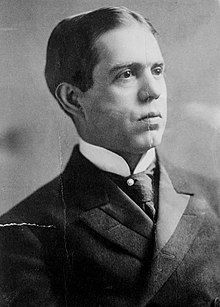William P. Jackson | |
|---|---|
 | |
| Treasurer of Maryland | |
| In office 1918–1920 | |
| Governor | Emerson Harrington |
| Preceded by | John M. Dennis |
| Succeeded by | John M. Dennis |
| United States Senator from Maryland | |
| In office November 29, 1912 – January 28, 1914 | |
| Appointed by | Phillips Lee Goldsborough |
| Preceded by | Isidor Rayner |
| Succeeded by | Blair Lee |
| Personal details | |
| Born | January 11, 1868 Salisbury, Maryland |
| Died | March 7, 1939 (aged 71) Salisbury, Maryland |
| Political party | Republican |
| Signature | |
William Purnell Jackson (January 11, 1868 – March 7, 1939) was a Republican member of the United States Senate, representing the State of Maryland from 1912 to 1914. His father, William Humphreys Jackson, was a U.S. Congressman from Maryland.
Biography
[edit]Jackson was born in Salisbury, Maryland, and attended the public schools of Wicomico County, Maryland and the Wilmington Conference Academy of Dover, Delaware. He engaged in the lumber business in 1887.
Jackson became a member of the Republican National Committee in 1908, and was appointed to the U.S. Senate to fill the vacancy caused by the death of Senator Isidor Rayner in 1912. While senator, Jackson served as chairman of the Committee on Expenditures in the Department of State (Sixty-second Congress).
A special election was called in 1913 to choose Rayner's successor, but Jackson chose not to become a candidate. He served from November 29, 1912, until January 28, 1914, when an elected successor, Blair Lee I, officially qualified for the position.
Following his short tenure in the Senate, Jackson resumed his former business pursuits in the lumber business. Jackson later served as Maryland State treasurer from 1918 to 1920; as president of the Salisbury National Bank; and a director of the Baltimore, Chesapeake & Atlantic Railway Company.
Jackson died in his hometown of Salisbury in 1939, and is buried at Parsons Cemetery. The home he built at Salisbury in 1893, the Sen. William P. Jackson House, was listed on the National Register of Historic Places in 1976, but demolished that same year.[1]
References
[edit]- Notes
- ^ "Maryland Historical Trust". Sen. William P. Jackson House, Wicomico County. Maryland Historical Trust. November 21, 2008.
- Bibliography
- United States Congress. "William P. Jackson (id: J000030)". Biographical Directory of the United States Congress.
External links
[edit] Media related to William P. Jackson at Wikimedia Commons
Media related to William P. Jackson at Wikimedia Commons- William P. Jackson at Find a Grave
- William Jackson at Flickr
